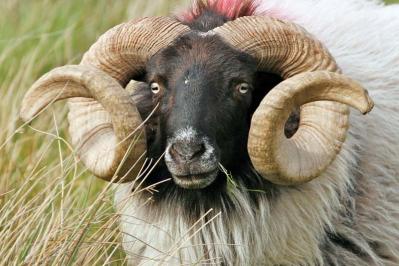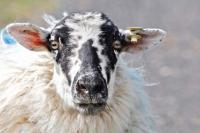December 30, 2015
By Judy Enright
Special to the BIR
 A Co. Mayo ram is a handsome specimen of his breed.
A Co. Mayo ram is a handsome specimen of his breed.
Well, why so many sheep photos with this month’s column you might wonder?
When I am asked what I like best about Ireland, I have to admit that I love the West Coast, and especially the sheep you find there. And, if you ask where I do my best sheep viewing, I’d say Co. Mayo and Co. Galway, although there certainly are sheep everywhere in Ireland – all too often in the middle of the road.
While it is nearly impossible to say exactly how many sheep there are, Eurostat (the European Union’s statistical office) reports that the country at last count had about 3.3-million. Additionally, Eurostat says about 4.5-million people live in Ireland (North and the Republic) so people do outnumber sheep, which was probably not always the case.
We were told some years ago that there are now laws in Ireland designed to keep sheep off the roads and that farmers are liable if their sheep cause accidents. But in spite of elaborate fencing along most roadways, there are still many sheep – and other animals –in the road. Seeing them wandering the byways makes for a scenic sight but a motorist’s nightmare – especially at night.
WOOL
The 3.3-million figure represents nearly 1.2-million fewer sheep than were in the country a decade ago. Among many reasons is the diminished popularity of wool, which was once a top seller. Many people (myself included) now favor fleece, which is not only warm but machine washable. I had a conversation in Doolin last year with a young man who said the famed hand-knit sweaters do not need to be dry-cleaned very often. He added that his dark blue Aran sweater was many years old and had never shown even the slightest sign of wear.
 Sweet-faced ewes are always curious about visitors.
Sweet-faced ewes are always curious about visitors.
Eurostat says Ireland has fewer sheep than Spain, Italy, Greece, France, Romania, Turkey and the UK. The highest sheep producer in Europe is Turkey, with 31.1-million - the UK is the second highest producer in Europe with the latest number at 23 million.
If you enjoy sheep as much as we do, there are numerous places around Ireland where you can stop, tour the farming facility, and meet some of the rams, ewes and lambs. One of my favorites is the Killary Sheep Farm on the banks of Killary Harbor in Connemara, Co. Galway, near the town of Leenane. Tom Nee, a young farmer, has created a wonderful tourist attraction there that has garnered many rave reviews from visitors. This is a traditional working mountain farm where some 200 ewes and lambs roam freely. Visitors can see sheepdog demonstrations, sheep shearing, and turf cutting demonstrations.
The farm is open April 1 to Sept. 30 and anyone interested in visiting is asked to call ahead. For more information, visit killarysheepfarm.com
Another well-known facility is the Kissane Sheep Farm, between Kenmare and Killarney National Park in Co. Kerry. To help
the farm survive, visitors have been welcomed there since 2005. If you are in the area, stop by and visit to see sheepdog demonstrations or sheep shearing during the summer. For more information, visit kissanesheepfarm.com or email noel@kissanesheepfarm.com
MAUREEN O’HARA
Although she had a great and very long run, it was still sad to learn that actress Maureen O’Hara, Ireland’s first great Hollywood star, died in October. Famed for her glorious red hair and her role in the 1952 classic “The Quiet Man” with John Wayne, she died at her home in Boise, ID, at 95. She appeared in more than 50 films during her career.
O’Hara was the daughter of Charles Stewart Parnell FitzSimons and his wife, Marguerita, and was born in Ranelagh, Dublin. The eldest of six children, she became a naturalized US citizen in 1946 and held dual citizenship.
She was buried at Arlington National Cemetery next to her third husband, Charles Blair, who captained the last scheduled seaplane flight out of Foynes on the Shannon River and was the first commercial pilot to fly into Shannon Airport when it opened in 1942. (A portion of the Flying Boats Museum in Foynes, Co. Limerick, is dedicated to Blair.)
O’Hara and Blair ran a commuter seaplane service, Antilles Airboats, in the US Virgin Islands. In 1978, as he was flying from St. Croix to St. Thomas, the plane’s engines failed and it crashed into the sea, killing Blair and three passengers.
After her husband’s death, O’Hara took over the business, becoming the first female president of a commercially scheduled airline in the US. She also published a monthly magazine, The Virgin Islander.
O’Hara’s West Cork holiday home, Lugdine Park, which comprises 35 acres in Glengarriff overlooking Bantry Bay, was sold last year to a couple from the UK for about 1.6-million euros. It was initially on the market for 2.3-million after she relocated permanently to the US to be closer to family.
O’Hara, according to her family, was, “proudly Irish and spent her entire lifetime sharing her heritage and the wonderful culture of the Emerald Isle with the world.” She had, they added, remained a champion of the arts, aviation, and all things Irish throughout her life and never lost her joy and wonder of these pursuits.
“For those who may ask what they can do to honor Maureen, we have a simple request: visit Ireland one day and think of her.” What a lovely thought and sentiment.
O’Hara’s daughter, Bronwyn, and grandson, Conor, survive her.
WILD NEPHIN
The Nephin Bog in Co. Mayo occupies the second largest tract of roadless land in Ireland. The bog is east of Ballycroy National Park, with which it shares the mountains of Slieve Carr and Nephin Beg.
Dubbed “Wild Nephin,” the 65,000-acre blanket bog and plantation forest has become part of a Europe-wide initiative to “re-wild” large areas across the EU.
Work will include revitalizing the ground, scarred by almost 1,000 years of draining for turf, returning the water table to within 10 centimeters of the surface, and forest regeneration to encourage natural growth of native species. A number of designated campsites will be built with primitive shelters, tent platforms, fire rings ,and toilet facilities.
While described as having the potential to become the envy of Europe, organizers say it may take up to 50 years to complete the project.
The bogland will also be a prime conservation area for endangered birds, such as the hen harrier. Animal and bird species in the area include otter, salmon, Golden Plover, Peregrine Falcon, Red Deer, Grey Heron, Kestrel, Merlin, White Fronted Geese, Irish Hare and others.
When done, the Wild Nephin will be one of the largest wilderness areas in the world.
THE NEW YEAR
It’s a new year and a new chance to make plans to visit Ireland and its many wonderful sheep and lambs. Lots of off-season deals are available now before the tourist season kicks in. Be sure to visit your favorite travel agent or any of the many websites that offer flights, ground travel and car rentals. And, enjoy the planning. A Co. Mayo ram is a handsome specimen of his breed.
A Co. Mayo ram is a handsome specimen of his breed.

